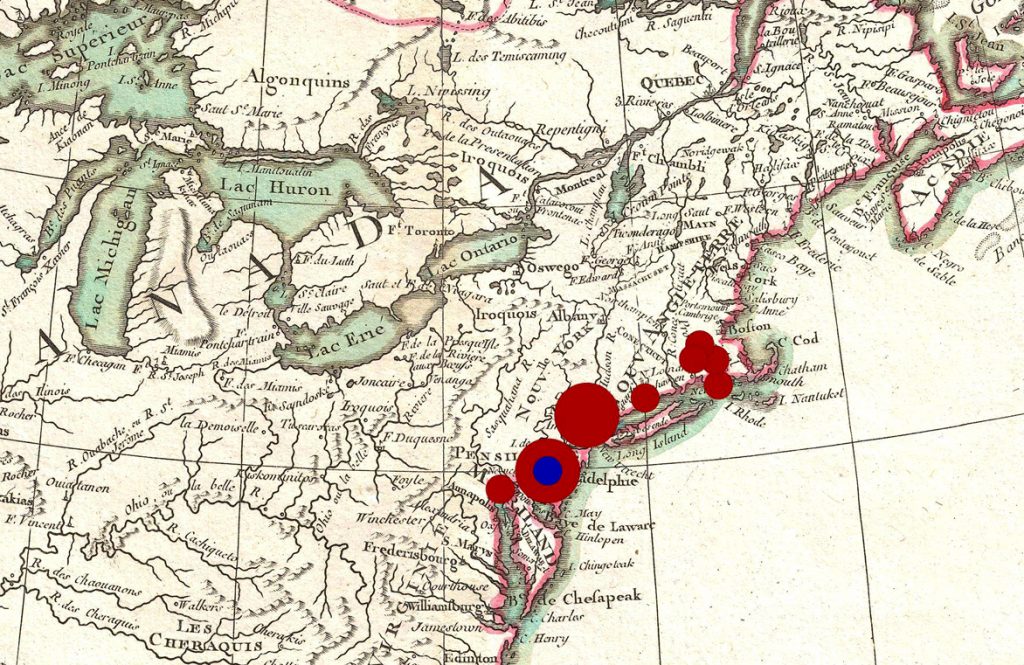In 1776, the Pennsylvania Evening Post printed a letter, allegedly from Paris, which reported that American commander Benedict Arnold had captured the last major British stronghold in Canada, Quebec City.[1] While almost certainly not the first of its kind, this letter from the Post is one of the earliest examples of fake news during the Revolutionary War. Quebec had not, in fact, surrendered to American troops at the time the letter was supposedly sent on January 4, 1776. Rather, less than a week before that date, the forces of Arnold and Gen. Richard Montgomery had been defeated in an assault on the city, during which Arnold had been injured and Montgomery had been killed. News of the defeat had spread widely by the time the letter from Paris was printed on April 6, 1776, so what was the intention of this fraudulent account? And what was its effect on American public opinion?
On the morning of New Year’s Eve, 1775, American forces attacked the city of Quebec, but were repulsed with relatively high losses in the first major American defeat during the invasion of Canada. By the 25th of January, news of the defeat had been printed in the Pennsylvania Evening Post, and in the weeks that followed, the report was reprinted at least eleven times in newspapers across the country.[2] Other relatively accurate reports of the defeat quickly followed.[3] Seemingly, the fraudulent letter’s anonymous author hoped that the fake news in their account would enjoy a similar circulation to that of the accurate report of Montgomery’s defeat at Quebec, which the very same Post had published three months earlier. The anonymous letter writer, however, was apparently to be sorely disappointed.
The fake report in the Post seems to have received essentially no traction in the American press, and it was not reprinted once (Figure 1). Perhaps the report was an honestly mistaken account of the actual attack that readers mostly overlooked. Perhaps it momentarily convinced some that the news was true, though not enough write about it or to reprint it. Or perhaps, as seems to be the case, most Americans saw through the fraud and simply ignored it. Whatever the case, the letter from the Pennsylvania Evening Post which claimed that the American conquest of Canada had been completed in January 1776 remains one of the earliest examples of fake news during the Revolutionary War, and likely one of the last before the founding of the new United States of America three months later.

Watch the video:
[1]Pennsylvania Evening Post, April 6, 1776.
[2]Pennsylvania Evening Post, January 25, 1776; Pennsylvania Ledger: or the Virginia, Maryland, Pennsylvania, & New-Jersey Weekly Advertiser, January 27, 1776; Constitutional Gazette, January 31, 1776; Maryland Journal, January 31, 1776; Pennsylvania Gazette, January 31, 1776; New-York Journal, February 1, 1776; Providence Gazette, February 3, 1776; New-York Gazette, and Weekly Mercury, February 5, 1776; Newport Mercury, February 5, 1776; Norwich Packet, February 5, 1776; Connecticut Journal, February 7, 1776; Thomas’s Massachusetts Spy Or, American Oracle of Liberty, February 9, 1776.
[3]Connecticut Courant, February 19, 1776; Connecticut Gazette, February 23, 1776; Constitutional Gazette, February 24, 1776; New-York Gazette, and Weekly Mercury, February 26, 1776; Pennsylvania Ledger: or the Virginia, Maryland, Pennsylvania, & New-Jersey Weekly Advertiser, March 2, 1776.








One thought on “Fake News of the Surrender of Quebec: A Video Contribution”
Thanks Jonathan, this is an interesting article on some very quirky news reporting–good job finding a needle in the haystack of inconsistent Revolutionary War newspaper reporting. It was also nice to see your video format as a different approach to sharing the information.
I noticed that The Philadelphia Evening Post published this Quebec news item under a “London, January 18” dateline. It would be interesting to see if the article was, in fact, originally published in any London newspapers. Unfortunately I don’t have access to historic British papers right now to see on my own.
Purely hypothesizing based on the few context clues, but if it actually was published in London on January 18, might it have been a deliberate misinformation effort, possibly to influence the Ministry’s plans for North America that year? The news item itself creates a strange set of circumstances to explain why it did not go to London first, allegedly having come through a ship that put into Nantes, France. There seem to be some intriguing questions that could follow if someone was interested in pursuing this strange Philadelphia Evening Post article further.